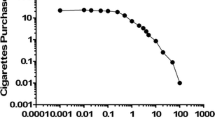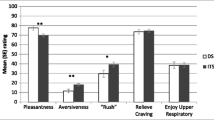Abstract
Introduction
The cigarette purchase task (CPT) is a method that can be used to assess the relative value of cigarettes. Based on cigarettes purchased across a price range, five derived metrics (Omax, Pmax, breakpoint, intensity, and elasticity) can assess cigarette demand. A study with adolescent smokers found that these could be reduced to two latent factors: persistence (price insensitivity) and amplitude (volumetric consumption). We sought to replicate this structure with adult smokers and examine how these variables relate to cessation efforts.
Method
Web-based survey conducted in 2014 among adult (18 years and above) current daily cigarette smokers (N = 1194). Participants completed the CPT, Fagerstrom Test for Nicotine Dependence (FTND), reported past-year quit attempts, and future quit intentions. We included published scales assessing perceived prevalence of smoking, social reactivity, smoker identity, and risk perception.
Results
Our analysis supported two latent variables, persistence and amplitude, which correlated positively with FTND. Persistence was correlated with several psychosocial factors and was higher among those intending to quit very soon, but did not vary by number of past-year quit attempts. Amplitude differed across quit attempts and intention (p < 0.001) and, in multivariable models, was significantly associated with lower 30-day quit intention (OR = 0.76, p = 0.001).
Conclusions
Persistence and amplitude factors characterized CPT data in adults, discriminated known groups (e.g., smokers by intentions to quit), and were positively associated with nicotine dependence. Factor scores also appear to relate to certain psychosocial factors, such as smoker identity and perceptions of risk. Future research should examine the predictive validity of these constructs.
Similar content being viewed by others
References
Bickel WK, Jarmolowicz DP, Mueller ET, Gatchalian KM (2011) The behavioral economics and neuroeconomics of reinforcer pathologies: implications for etiology and treatment of addiction. Curr Psychiatry Rep 13:406–415
Bidwell LC, MacKillop J, Murphy JG, Tidey JW, Colby SM (2012) Latent factor structure of a behavioral economic cigarette demand curve in adolescent smokers. Addict Behav 37:1257–1263
Borland R, Yong HH, Cummings KM, Hyland A, Anderson S, Fong GT (2006) Determinants and consequences of smoke-free homes: findings from the International Tobacco Control (ITC) Four Country Survey. Tobacco control 15(Suppl 3):iii42–iii50
Borland R, Yong HH, O’Connor RJ, Hyland A, Thompson ME (2010) The reliability and predictive validity of the Heaviness of Smoking Index and its two components: findings from the International Tobacco Control Four Country study. Nicotine Tob Res 12(Suppl):S45–S50
Collins RL, Vincent PC, Yu J, Liu L, Epstein LH (2014) A behavioral economic approach to assessing demand for marijuana. Exp Clin Psychopharmacol 22:211–221
Costello MJ, Logel C, Fong GT, Zanna MP, McDonald PW (2012) Perceived risk and quitting behaviors: results from the ITC 4-country survey. Am J Health Behav 36:681–692
Dohnke B, Weiss-Gerlach E, Spies CD (2011) Social influences on the motivation to quit smoking: main and moderating effects of social norms. Addict Behav 36:286–293
Hatsukami DK, Vogel RI, Severson HH, Jensen JA, O’Connor RJ (2015) Perceived Health Risks of Snus and Medicinal Nicotine Products. Nicotine Tob Res [Epub ahead of print]
Heatherton TF, Kozlowski LT, Frecker RC, Fagerstrom KO (1991) The Fagerstrom Test for Nicotine Dependence: a revision of the Fagerstrom Tolerance Questionnaire. Br J Addict 86:1119–1127
Heckman BW (2014) Self-Control Depletion and Nicotine Deprivation as Precipitants of Smoking Cessation Failure: A Human Laboratory Model Psychology. University of South Florida, Graduate Theses and Dissertations
Hitchman SC, Fong GT, Zanna MP, Thrasher JF, Laux FL (2014) The relation between number of smoking friends, and quit intentions, attempts, and success: findings from the International Tobacco Control (ITC) Four Country Survey. Psychol Addict Behav 28:1144–1152
Hursh SR (2014a) Behavioral economics and the analysis of consumption and choice. In: McSweeney FK, Murphy ES (eds) The Wiley Blackwell handbook of operant and classical conditioning. John Wiley & Sons, Hoboken, pp 275–305
Hursh SR (2014b) Generalized essential value based on exponential demand. Society for the Quantitative Analyses of Behavior, Chicago
Hursh SR, Silberberg A (2008) Economic demand and essential value. Psychol Rev 115:186–198
Hyland A, Higbee C, Travers MJ, Van Deusen A, Bansal-Travers M, King B, Cummings KM (2009) Smoke-free homes and smoking cessation and relapse in a longitudinal population of adults. Nicotine Tob Res 11:614–618
Jacobs EA, Bickel WK (1999) Modeling drug consumption in the clinic using simulation procedures: demand for heroin and cigarettes in opioid-dependent outpatients. Exp Clin Psychopharmacol 7:412–426
Kaplan BA, Reed DD (2014) Essential value, Pmax, and Omax automated calculator (spreadsheet application). KU Scholarworks, University of Kansas, http://hdl.handle.net/1808/14934
Klabbers G, Bosma H, Van den Akker M, van Boxtel M, Kempen G, McDermott M, Van Eijk JTM (2009) Measuring Rebelliousness and Predicting Health Behaviour and Outcomes An Investigation of the Construct Validity of the Social Reactivity Scale. J Health Psychol 14:771–779
Koffarnus MN, Franck CT, Stein JS, Bickel WK (2015) A modified exponential behavioral economic demand model to better describe consumption data. Exp Clin Psychopharmacol 23:504–512
Kozlowski LT, Porter CQ, Orleans CT, Pope MA, Heatherton T (1994) Predicting smoking cessation with self-reported measures of nicotine dependence: FTQ, FTND, and HSI. Drug Alcohol Depend 34:211–216
MacKillop J, Murphy JG (2007) A behavioral economic measure of demand for alcohol predicts brief intervention outcomes. Drug Alcohol Depend 89:227–233
MacKillop J, Tidey JW (2011) Cigarette demand and delayed reward discounting in nicotine-dependent individuals with schizophrenia and controls: an initial study. Psychopharmacology (Berl) 216:91–99
MacKillop J, Murphy JG, Ray LA, Eisenberg DT, Lisman SA, Lum JK, Wilson DS (2008) Further validation of a cigarette purchase task for assessing the relative reinforcing efficacy of nicotine in college smokers. Exp Clin Psychopharmacol 16:57
Mackillop J, Murphy JG, Tidey JW, Kahler CW, Ray LA, Bickel WK (2009) Latent structure of facets of alcohol reinforcement from a behavioral economic demand curve. Psychopharmacology (Berl) 203:33–40
MacKillop J, Miranda R Jr, Monti PM, Ray LA, Murphy JG, Rohsenow DJ, McGeary JE, Swift RM, Tidey JW, Gwaltney CJ (2010) Alcohol demand, delayed reward discounting, and craving in relation to drinking and alcohol use disorders. J Abnorm Psychol 119:106–114
MacKillop J, Brown CL, Stojek MK, Murphy CM, Sweet L, Niaura RS (2012) Behavioral economic analysis of withdrawal- and cue-elicited craving for tobacco: an initial investigation. Nicotine Tob Res 14:1426–1434
Mackillop J, Murphy CM, Martin RA, Stojek M, Tidey JW, Colby SM, Rohsenow DJ (2015) Predictive Validity of a Cigarette Purchase Task in a Randomized Controlled Trial of Contingent Vouchers for Smoking in Individuals With Substance Use Disorders. Nicotine Tob Res [Epub ahead of print]
Madden GJ, Kalman D (2010) Effects of bupropion on simulated demand for cigarettes and the subjective effects of smoking. Nicotine Tob Res 12:416–422
McClure EA, Vandrey RG, Johnson MW, Stitzer ML (2013) Effects of varenicline on abstinence and smoking reward following a programmed lapse. Nicotine Tob Res 15:139–148
Mills AL, Messer K, Gilpin EA, Pierce JP (2009) The effect of smoke-free homes on adult smoking behavior: a review. Nicotine Tob Res 11:1131–1141
Murphy JG, MacKillop J (2006) Relative reinforcing efficacy of alcohol among college student drinkers. Exp Clin Psychopharmacol 14:219–227
Murphy JG, MacKillop J, Skidmore JR, Pederson AA (2009) Reliability and validity of a demand curve measure of alcohol reinforcement. Exp Clin Psychopharmacol 17:396–404
Murphy JG, MacKillop J, Tidey JW, Brazil LA, Colby SM (2011) Validity of a demand curve measure of nicotine reinforcement with adolescent smokers. Drug Alcohol Depend 113:207–214
Murphy JG, Dennhardt AA, Yurasek AM, Skidmore JR, Martens MP, MacKillop J, McDevitt-Murphy ME (2015) Behavioral economic predictors of brief alcohol intervention outcomes. J Consult Clin Psychol 83:1033–1043
O’Connor BP (2000) SPSS and SAS programs for determining the number of components using parallel analysis and Velicer’s MAP test. Behav Res Methods Instrum Comput 32:396–402
O’Connor RJ, June KM, Bansal-Travers M, Rousu MC, Thrasher JF, Hyland A, Cummings KM (2014) Estimating demand for alternatives to cigarettes with online purchase tasks. Am J Health Behav 38:103–113
Savoy E, Reitzel LR, Scheuermann TS, Agarwal M, Mathur C, Choi WS, Ahluwalia JS (2014) Risk perception and intention to quit among a tri-ethnic sample of nondaily, light daily, and moderate/heavy daily smokers. Addict Behav 39:1398–1403
Schlienz NJ, Hawk LW Jr, Tiffany ST, O’Connor RJ, Mahoney MC (2014) The impact of pre-cessation varenicline on behavioral economic indices of smoking reinforcement. Addict Behav 39:1484–1490
Stein JS, Koffarnus MN, Snider SE, Quisenberry AJ, Bickel WK (2015) Identification and management of nonsystematic purchase task data: toward best practice. Exp Clin Psychopharmacol 23:377–386
Tombor I, Shahab L, Brown J, West R (2013) Positive smoker identity as a barrier to quitting smoking: findings from a national survey of smokers in England. Drug Alcohol Depend 133:740–745
van den Putte B, Yzer M, Willemsen MC, de Bruijn GJ (2009) The effects of smoking self-identity and quitting self-identity on attempts to quit smoking. Health Psychol 28:535–544
Yong HH, Borland R, Balmford J, Hyland A, O’Connor RJ, Thompson ME, Spittal MJ (2014) Heaviness of smoking predicts smoking relapse only in the first weeks of a quit attempt: findings from the International Tobacco Control Four-Country Survey. Nicotine Tob Res 16:423–429
Author information
Authors and Affiliations
Corresponding author
Ethics declarations
Conflict of interests
The authors declare that they have no conflict of interest.
Funding
This work was supported by a cooperative agreement from the National Cancer Institute (U19CA157345). Bryan W. Heckman was supported by K12DA031794.
Rights and permissions
About this article
Cite this article
O’Connor, R.J., Heckman, B.W., Adkison, S.E. et al. Persistence and amplitude of cigarette demand in relation to quit intentions and attempts. Psychopharmacology 233, 2365–2371 (2016). https://doi.org/10.1007/s00213-016-4286-x
Received:
Accepted:
Published:
Issue Date:
DOI: https://doi.org/10.1007/s00213-016-4286-x




